You
are receiving this because your address is subscribed at: www.jaunay.com/newsletter.html |
|
 |
| No: 60 |
February 2011
|
|
News February Seminars 20: Coming to grips with FamilySearch, WEA Centre Adelaide, 10:00am to 1:00pm March Seminars 5: Family History on the Web, WEA Centre Adelaide, 10:00am to 1:00pm 27: Coming to grips with FamilySearch, WEA Centre Adelaide, 10:00am to 1:00pm See the seminar program for more details and bookings. Using web translators As pointed out in the previous newsletter, a successful family historian pursues their distant cousins because we all descend from individuals in a multitude of families. Some of those individuals, simply because of their circumstances, may have become custodians of family knowledge and/or artifacts that they in their turn passed on to one of their family and so on down to the present. It is therefore quite possible, even probable, that a distant cousin may hold this knowledge or artifacts. In fact the more remote your cousin, the greater the chance they hold the information you seek! What if you discover a remote non-English speaking cousin? Not only does etiquette suggest that if you are initiating a request of information you should have the courtesy of using the recipient's language, but more importantly if you want an answer you need to employ as many strategies as possible to encourage this result. If the recipient of your message needs to find a translator, then you are placing a barrier to your goal! Some of my French cousins are as well versed in English as I am, but when I first discovered them I was not to know that and in some cases I suspect that if I communicated with them in written English, they may have chosen not to reply! Fortunately we live in a high tech world that make this problem relatively easy to overcome as long as you follow a few basic guidelines. |
In
this issue: |
|
Graham Jaunay Services |
| You have probably noticed when searching Google that some foreign language sites can be translated by Google. That is because Google uses similar technology to that outlined in the following material. 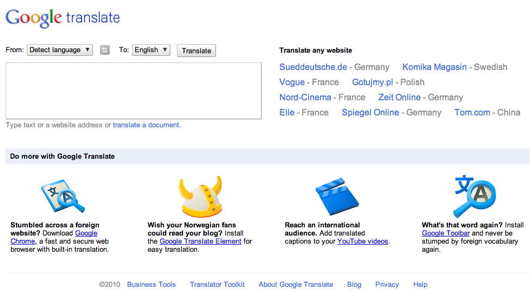 One of the sites to assist you with translations is known as Babelfish. It is not necessarily the only site you can use and you should check others for their strengths and weaknesses. In the case of Babelfish, the site cannot only translate some foreign language sites but also be used to draft text. If Babelfish does not offer the language sought, then you need to seek out a site that does. Babelfish was the original translator but is being rapidly overtaken by others.
These are not the only sites offering these services. You may like to check out the following: WorldLingo 32 languages including Chinese (traditional) and Farsi. It also has an accented letters feature. FreeTranslation offers many languages with the helpful accented letters features as well as an automatic back translator. The sites can translate web pages into broken English, but I find them more useful to translate my writings. All the sites reviewed will translate web sites to varying degrees of accuracy. 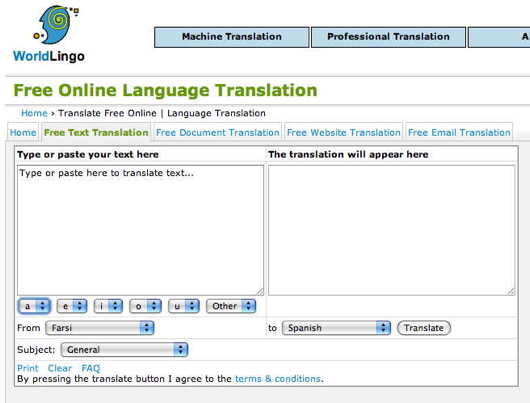 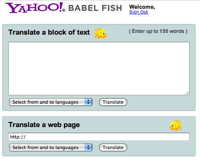 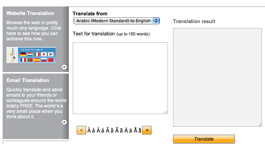 Once you have selected your translator site then if you wish to translate some text to paste into an email or hard copy to a letter, there are some basic rules to observe to ensure the task has the best outcome possible. Step 1: Keep it simple. When writing text write as though you are in your first days of school and write simple sentences comprising of a subject, verb and object only as in, The cat sat on the mat. Every time you are tempted to make the sense more complicated you are invoking complex grammar rules that either the translator software will not be able to handle or the target language does not recognise. The following simple sentence is handled well by each translator as indicated below. Although not always precisely translated, The cat sat on the mat. would be understood by all. Google (Indonesian) Kucing itu duduk di tikar. (The cat sat on the mat.) Babelfish (German) Die Katze saß auf der Matte. (The cat sat on the mat.) Applied Language (French) Le chat était assis sur le tapis. (The cat sat on the carpet.) SDL (Mexican) El gato se sentó en la estera. (The cat sat down in the mat.) Dictionary.com Translator (Hungarian) A macska ült a szönyegen. (The cat sat on the carpet.)  Step 2: Always take the translation and translate it back into English. If it comes back as nonsense, it is probably nonsense in the foreign language. If you have observed step 1 above carefully, then the problem will be that the software does not recognise a word or the programmer has not inputted that word into the vocabulary and so the software either ignores it or makes the best guess. In the following example using Babelfish we can see the problem: 1. input the simple sentence – The cat sat on the mat. 2. Babelfish translates that as – Le chat s'est reposé sur la natte. 3. When returned to English we get – The cat is rested on the plait. That means Babelfish software engineers have not translated mat into French and the software has made a guess that in this case made the result nonsense. Solution—use another translator or another word for mat such as carpet. In fact if you look at the examples in step 1 above you will see that Applied Language software and Dictionary.com Translator accommodated this problem! FreeTranslation offers many languages with a helpful automatic back translator (note arrow indicating this feature in the illustration) and it can handle the mat/carpet issue! 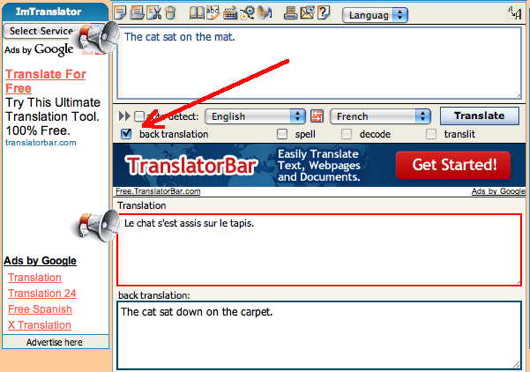 |
|||||||||||||||||||||||||||||||||||||||||||||||||||||||||||||||||||||||||||||||||||||||||||||||||||||||||||||||||||||||||||||||||||||||||||||||||||||||||||||||||||||||||||||||||||||||||||||||||||||||||||||||||||||||||||||||||||||||||||||||||||||||||||||||||||||||||||||||||||||||||||||||||||||||||||||||||||||||||||||||||||||||||||||||||||||||||||||||||||||||||||||||||||||||||||||||||
| To
unsubscribe send a blank email via the following link using the same
address you subscribed to: newsletter-leave@jaunay.com |
|||||||||||||||||||||||||||||||||||||||||||||||||||||||||||||||||||||||||||||||||||||||||||||||||||||||||||||||||||||||||||||||||||||||||||||||||||||||||||||||||||||||||||||||||||||||||||||||||||||||||||||||||||||||||||||||||||||||||||||||||||||||||||||||||||||||||||||||||||||||||||||||||||||||||||||||||||||||||||||||||||||||||||||||||||||||||||||||||||||||||||||||||||||||||||||||||